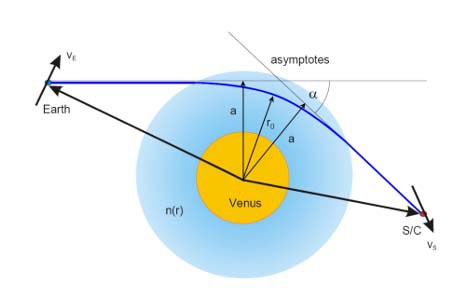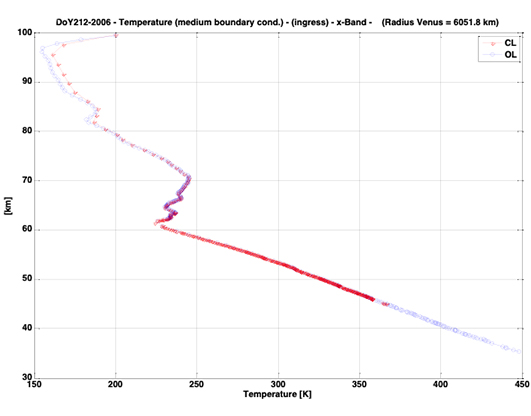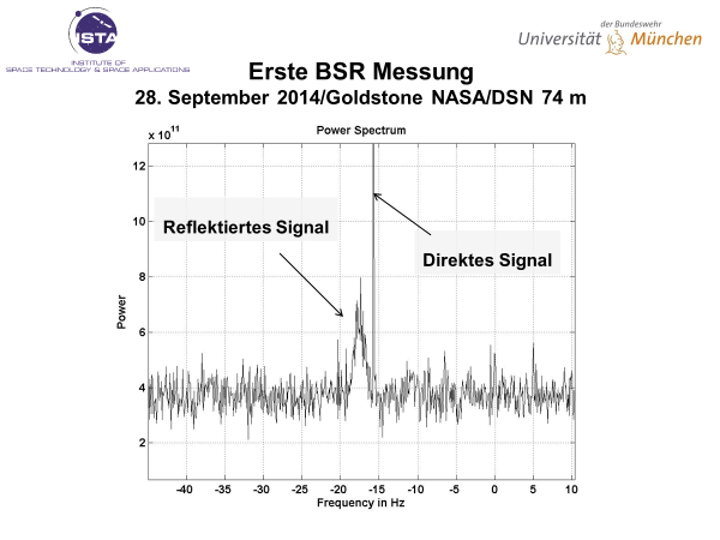Author: Prof. Dr. rer. nat. Bernd Häusler
At the beginning of the 1990s, Professor Häusler focused his research activities at the former Institute of Space Technology (now ISTA) on studying the solar system using radio science technology. His research concerned the study of planets and their atmospheres, ionospheres and surfaces (comparative planetary science), the physical properties of moons, comets and asteroids, as well with the dynamics of the solar corona (CMEs: coronal mass ejections).
Together with an international team of scientists (from Germany, the USA, Belgium, France and Japan), Professor Häusler submitted proposals for experiments concerning comet, Mars and Venus missions of the European Space Agency (ESA). All three proposals were accepted and Häusler was entrusted with important tasks in the radio science experiments (co-investigator and experiment/mission manager for the Mars Express and Rosetta missions, principal investigator of the Venus Express mission). The carrier rockets were launched on June 2, 2003 (Mars), March 2, 2004 (Rosetta) and November 9, 2005 (Venus). The Venus Express (VEX) orbiter burned up on November 28, 2014 in the Venusian atmosphere. The Rosetta mission was concluded on September 30, 2016, when the orbiter was hard-landed onto the comet after a 10-year journey towards the comet and a subsequent investigation phase. The Mars spacecraft (Mars Express - MEX) is still sending data to Earth. All three missions have been a great success for the Institute of Space Technology.
The Technology
Radio science research is divided into three general categories of observation technology. These categories all examine the propagation of ultra-stable microwaves in space. When electromagnetic waves travel from a satellite to a ground station and pass through an atmospheric medium, important parameters of planetary atmosphere (temperature, pressure, winds) can be observed through variations induced by the waves (e.g. phase shift, which can be measured as a frequency shift at the ground station). When two different phase-coherent frequencies are used, non-dispersive and dispersive media effects can be separately observed. This allows scientists to distinguish between neutral atmospheres and ionized media such as ionospheres or solar wind plasma. Radio occultation plays an important role in planetary science. When a satellite orbiting a planet passes behind that planet as viewed from Earth, the reception of the radio waves on Earth is not immediately interrupted. The signals will continue to be “visible” for some time since radio waves first pass through the ionosphere/atmosphere before being completely blocked by the planet (this happens in reverse order when the satellite emerges from behind the planet) (see Fig. 1). These occultation events allow us to study atmospheres.1,2,3 Fig. 2 shows a typical temperature profile of the Venusian atmosphere derived from such observations.

Fig. 1 Constellation of satellite and ground station for a radio occultation experiment involving Venus. Through an inverse Abel transformation, the bending angle α and asymptote distance a are used to determine the refractive index n at r0. To do this, we must know with astronomical accuracy the transmission time and the barycentric position and velocity vectors. For the radio occultation experiment involving Venus, only transmissions from the satellite to the ground station were measured (one-way mode).
By studying the scattering of radio waves from planetary or comet surfaces through the observed polarization effects, we can deduce surface parameters of a celestial body such as roughness and dielectric constant. Such radar experiments are called “bistatic” since the transmitter and the receiver of the signal – in our case the satellite and the ground station – are physically separated. We conducted bistatic radar surface investigations for Mars, Venus and the comet.4
Unlike occultation and bistatic radar experiments, frequency shifts of the transmitted signals that are not caused by medium effects but by changed velocity vectors of a satellite when orbiting or flying by a body in space on account of gravitational effects (Doppler effect) can be used to analyze gravitational potential and to provide information on the mass and internal mass distribution of a body. Measurements were performed for Mars and its moon Phobos, the asteroid Lutetia, and the Rosetta mission comet 67P/Churyumov-Gerasimenko.5,6,7,8
Investigations of Mars, Venus and the Rosetta Mission Comet
The occultation events investigated as part of the Mars Radio Science Experiment (MaRS) included both hemispheres and regions in the lowest part of the atmosphere at an altitude of approximately 50 km above the surface. We were able to study the planetary boundary layer, atmospheric Kelvin waves, and gravity waves. Another field of study was the Martian ionosphere with its day-time, seasonal and solar cycle variations. We developed models that allow us to study the extremely thin neutral atmosphere from the ionosphere at great altitudes.5
The investigations of Venus were particularly challenging since the Venusian atmosphere is composed of an extremely dense and hot CO2 layer that causes a considerable greenhouse effect. The surface temperature and pressure are 730 K and 92 bar respectively. In addition, Venus is the only planet in the solar system that rotates clockwise (retrograde rotation) and very slowly with a rotational period of 243 Earth days. Zonal winds in the cloud layers still reach extremely high velocities (up to 130m/s; superrotation).9, 10 All mission participants gained valuable insights into planetary atmospheric physics from the VeRa data, which paved the way for new fields of research. In our study of the medium layer of Venus’ atmosphere, we are focusing more than ever on the processes of impulse and heat transfer in the atmosphere and the interaction of meridional convection, gravity waves, thermal tides and atmospheric instabilities.
For planetary investigations, we are using ray tracing based on radial atmospheric density gradients and spherical symmetry (Fig.1). Ray tracing can be calculated with a sensitivity of 10 -6 °. When the bending angle α and the asymptotic distance a are known for a specific point in time, the laws of optics permit us to calculate the refractive indices of the atmosphere at the points at which ray paths are closest to the planet. This allows us to create vertical atmospheric altitude profiles (Fig. 2). We measured pressure and temperature by assuming hydrostatic equilibrium in the known chemical composition of the atmosphere and by using various mathematical manipulations (inverse Abel transformation). To avoid unnecessary power loss at the receiver signal of the ground station, the antenna beam had to be dynamically directed during an occultation event along the expected ray path. Several months prior to the experiment, ISTA had calculated with astronomic accuracy the 3-axis attitude determination maneuvers of the Venus satellite. The maneuvers were then uploaded to the command memory of the satellite. When we calculated the time and frequency data, we considered relativistic effects. Not only in this regard has ESA had great trust in the work of ISTA.
Since Mars has an extremely thin atmosphere (surface pressure ~ 5 mbar), these maneuvers were not required. Measurements were made using the Earth pointing mode and the antenna beam always pointed to the ground station. The required frequency stability of the microwave carrier signals was ensured only by the ground station with its H2 Maser and transferred through the uplink via the coherent transponder onboard the satellite to the downlink. In the case of Venus, we only measured the downlink data. The frequency stability (Allan deviation) had to be provided by the onboard reference oscillator (ultra-stable crystal oscillator - USO). The USO for the comet mission was used in a similar way. The frequency stability of the specifically designed USOs was Δf/f ~ 3x 1013, which allowed us to perform measurements – in particular for Venus and the comet – that would have been impossible with the crystal oscillators normally used in satellites. The USOs were manufactured by TimeTech GmbH in Stuttgart and were tested and integrated into the satellites by ISTA. A mobile microwave test laboratory was set up at the institute for this purpose.
The Venusian atmosphere has not only high temperatures but also large temperature gradients. This causes dynamic effects of up to 200 Hz/s when using standard receiving techniques at the ground station (closed-loop or PLL). There are also defocusing and attenuation losses of 30 to 40 dB. At the ground station, ISTA therefore uses the specifically designed open-loop receiving system in addition to the CL technique. The open-loop system works without tracking a carrier signal. ISTA specifically developed a digital signal processing method to retrieve the carrier through sequential iterative decimation, down-conversion (to zero) and low-pass filtering of the amplitudes. This processing method also allowed us to retrieve from noisy incoming signals (C/N ~ 0 dB) from the deeper atmosphere the carrier signal with a noise ratio of only 50 mHZ and thus to penetrate into altitudes of 36 km (see Fig. 2). At an atmospheric altitude of ~ 60 km, we were able to detect for the first time multipath propagation caused by thin temperature inversion layers. We are also gaining valuable new insights from the joint evaluation of the Venus data provided by the European VEX mission and the Japanese Akatsuki mission.11
With the Rosetta mission, bistatic radar experiments were conducted for the first time on a comet (Churyumov/Gerasimenko) (see Fig. 3), for which the ultra-stability of the USO was especially useful. The data are still being analyzed. The gravitational field measurements of the comet showed a density of Ro = 537.8 +/- 0.6 kg/m3. This indicates that the nucleus is likely highly porous with a low percentage of ice. The radio science team therefore proposed calling the comet an “icy dirt-ball” instead of a “dirty ice-ball”.8
The ground stations used for the RSI were the standard 34-m ground station of the ESA and the 70-m Deep Space Communications Complex of NASA.
Valuable Contributions of ISTA
Only with the cooperation of the experienced international RSI team, the committed staff of the Institute, our students, and the participating industries and organizations were we able to perform these tasks and the analysis of scientific data. The author would like to thank everyone involved.
The fundamental questions of atmospheric physics remain, of course, unanswered. These missions and their experiments were, however, an important step in the right direction. The Japanese space probe Akatsuki, which is tasked with studying the atmosphere of Venus, is using an identically constructed USO from the VeRa experiment and will obtain further important results. The Japanese space agency JAXA has invited Professor Häusler to work as a co-investigator. At ISTA, Professor Förstner and Dr. Andert are currently working on ideas for future RSI missions.
Selected Publications
1Häusler, B., M. Pätzold, G.L. Tyler, R.A. Simpson, M.K. Bird, V. Dehant, J.-P. Barriot, W. Eidel, R. Mattei, S. Remus, J. Selle, S. Tellmann, T. Imamura: Radio science investigations by VeRa onboard the Venus Express spacecraft, Planet. Space Sci. 54, 1315-1335, 2006
2Häusler, B., M. Pätzold, G.L. Tyler, J.-P. Barriot, M.K. Bird, V. Dehant, D. Hinson, R.A. Simpson, R.A. Treumann, W. Eidel, R. Mattei, P. Rosenblatt, S. Remus, J. Selle, and S. Tellmann: Venus atmospheric, ionospheric, surface, and interplanetary radio propagation studies with the Venus Express Radio Science experiment VeRa, ESA Scientific publication SP-1295, 2007
3Pätzold, M., B. Häusler, M.K. Bird, S. Tellmann, R. Mattei, S.W. Asmar, V. Dehant, W. Eidel, T. Imamura, R.A. Simpson, G.L. Tyler: The structure of Venus middle atmosphere and ionosphere: Nature, 450, 657-660, 2007
4Simpson, R.A., Tyler, G.L., Pätzold, M., Häusler, B., Asmar S.W., Sultan-Salem, A.K.: Polarization in Bistatic Radar Probing of Planetary Surfaces: Application to Mars Express Data: Proc. IEEE 99, 858-874, 2011
5Pätzold, M., B. Häusler, G.L. Tyler, T. Andert, et al.: Review Article, Mars Express 10 years at Mars: Observations by the Mars Express Radio Science Experiment (MaRS), Planet. Space Sci., http://doi.org./10.1016/j.pss.2016.02.013
6Pätzold, M., T.P. Andert, G.L. Tyler, S.W. Asmar, B. Häusler, S. Tellmann: Phobos mass determination from the very close flyby of Mars Express in 2010, Icarus, 229, 92-98, 2014
7Pätzold, M., T.P. Andert, S.W. Asmar, J.D. Anderson, J.-P- Barriot, M.K. Bird, B. Häusler, M. Hahn, S. Tellmann, H. Sierks, P. Lamy, B.P. Weiss: Asteroid 21 lutetia: Low mass, High Density, Science, 334, 491-492, 2011
8Pätzold, M., T.P. Andert, M. Hahn, S.W. Asmar, J.-P- Barriot, M.K. Bird, B. Häusler, K. Peter, S. Tellmann E.Grün, P.R. Weissmann, H. Dierks, L. Jorda, R. Gaskell, F. Preusker, F. Scholten: A homogeneous nucleus for comet 67P/Churyumov-Gerasimenko from its gravity field, Nature 530, 63-65, 2016
9Tellmann, S., M. Pätzold, B., M.K. Bird, and G.Leonhard Tyler: Structure of the Venus neutral atmosphere as observed by the Radio Science experiment VeRa on Venus Express, J. Geophys. Res., 114, E00B36, 2009
10Tellmann, S., B. Häusler, D.P. Hinson, G.L. Tyler, T.P. Andert, M.K. Bird, T. Imamura, M. Pätzold, S. Remus, Small-scale temperature fluctuations seen by the VeRa Radio Science Experiment on Venus Express, Icarus 22, 471-480, 2012
11Ando, H. T. Imamura, S. Tellmann, M. Pätzold, B. Häusler, N. Sugimoto, M. Takagi, H. Sagawa, S. Limaye, Y. Matsuda, R.K. Choughary & M. Antonita: Thermal structure oft he Venusian atmosphere from the sub-cloud region tot he mesosphere as observed by radio occultation, (2020), www.nature.com/scientificreports, 10:3448, doi.org/10.1038/s41598-020-59278-8


